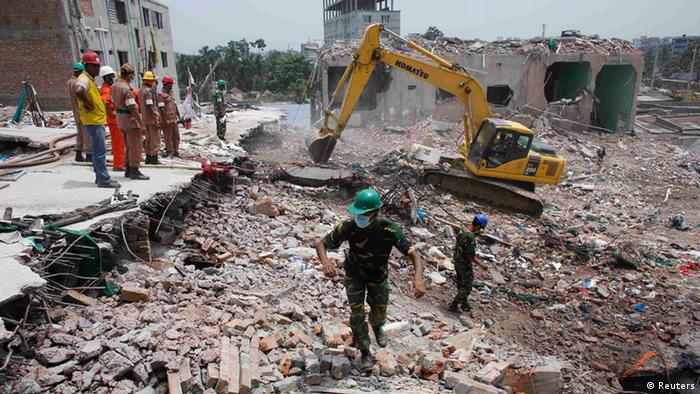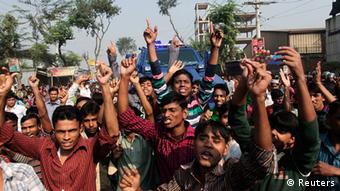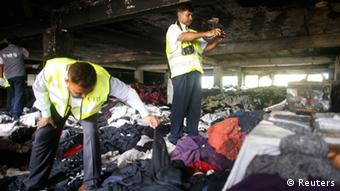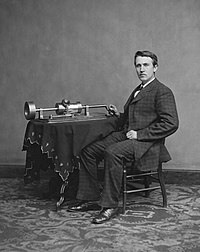大同大學工程管理組邀請華人戴明學院院長 鍾漢清先生演講
這個交流的目的,是要探討如何從淵博知識系統的思考方式來看物料管理。
格言:如果你有一把鎚子,所有問題看起來都像是釘子。
大綱
什麼是戴明博士的淵博知識系統?
一些產業的經驗談
物料管理的系統觀
目的
目標
戰略
戰術 戰情室
生產系統-物流系統-SIPOC
傳統物料管理職能上的界定
系統的重要績效指標
新會計看法:ABC/Throughtput/JIT/
Order
供應商的哲學與管理
物料管理上的變異
可運作定義”設計的主要參數考量
系統穩定性的要求
瓶頸問題
物料管理上的學習
如何PDSA與持續改善
物料管理作為社會-心理系統
如何在組織之中發揮效能
Cases Study for Materials Management: 郭台銘:供應鏈拯救世界,臺灣壹集團 ,台灣連鎖便利商,HTC: the One: microphone...
Amazon
Zara (Inditex 公司品牌) 如何瘋長為全球最大時裝零售商
優衣庫(Uniqlo)的新旗艦店在香港 (3500萬中國訪客)最繁華的商業地區之一的中心地帶開業,突顯出這座城市對尋求開拓寬廣大陸市場的零售商的持久吸引力。
這家商店佔據了三層樓,中庭懸掛着可上下移動的假人模特。只過了不到半小時,商店就似乎進入了正常營業狀態:顧客們熱情地搶購五顏六色的休閑服飾,而這類服飾正是優衣庫這個日本迅銷公司(Fast Retailing)旗下最知名品牌的特色。.....
參考資料
拙著《生產管理:策略與實務》
拙著《系統與變異:淵博知識與理想設計法》(Systems and
Variations: 2010 Deming Memorial Speeches)
拙譯《精實系統》Lean Thiking
網頁
林世堂: 學期剛開始,先讓我介紹一些觀念及大致流程,然後輔以您的實務,如此就非常棒!所以應該先暫定在4月底左右。 謝謝您情義相挺,之前有時瑋來幫忙上體驗建築,溫堅來上財務管理,所以我是很幸福!有如此多好友!
hc: 了 解. Materials management 是我在Philips的第一國際訓練 他們從goods flow(物流) 的角度來談它. 我們一些同事(成本分析專家)都轉調到物料-採購之經理(為什麼要有sourcing專業.....). 庫存/自動倉儲.....是很大的. 由於工場機器相當多. 機械保養的備品spare parts管理也很重要.....所以題目可這樣決定 需要正式的說法/大綱嗎? 何時要交給你?
Onionhead Cerebrum
鍾老師,謝謝你回應與接受連結邀請。幾年前,或說十幾年前有過一面之緣,跟老師訂了幾本品質經營與精實生產的著作,承蒙老師親自送書到中山北路當時任職公司。老師著作令個人獲益極多,感恩。
哇 謝謝你. 你的本名叫什麼?
又Bill Scherkenbach 給拙著《系統與變異:淵博知識與理想設計法》(Systems and Variations: 2010 Deming Memorial Speeches) 寫的序紀念此段因緣。
序言
2008 年我住在台灣,漢清邀請我在台北和東海大學兩地主持「戴
明紀念講座」。該講座的主題是「戴明的淵博知識」。與會者主要是
大學生和資深的品管人。
站上講台時,我才明白,為什麼戴明博士當年去日本講學時,會
那樣興奮,因為他們每人都樂意學習,並努力去運用所學。我的
1998-99 年職務,讓我看到了台灣和中國的許多朋友,他們求知若
渴,也很讓我感動。但是,管理者的情形則不同。大多數的中國的
外資公司,是由台灣或日本的經理來管理,因為他們了解現代商業
的實務。一旦有品質問題,他們會採用更多的檢查和修理來處理它
們,因為當地的勞動力相對便宜。
為了營運,他們非常願意嘗試許多方法:精實,六西格瑪,方
針管理,供應商管理工程師,向各地的 OEM 廠商請業務員,銷售
等。我覺得他們可能有機會接受數十年前業已紮根的理念。我錯
了。嗯,幾乎是錯誤。博士戴明的哲學仍然與 10億左右善良工人產
生強烈共鳴,但管理層的想法,卻被灌輸了一種由西方商學院所誤
導的課程和全球商界的胡說八道的混合物。請記住戴明博士的教
誨:採取更多的成本中心來控制並不是答案。更多更廣泛的資訊科
技,並不是答案。更注重於缺陷也並勿不是答案。更多的內部競爭,消
除表現低於平均水準的員工也不是答案。在管理命令鏈給人更多的
恐懼和恐嚇,也不是答案。答案是什麼呢?答案是要用淵博的知識
當我們經營管理的基礎。
今年是戴明博士 110 歲生日,你有機會學到一些應該會改變你
的生活,讓它更為美好的東西。如果你了解如何去管理變化,你的
生活會變得更好。如果你知道萬事的原因和影響,並不會立即聯繫
在一起,你的生活會變得更好。在不利的方面,知識是一種負擔。套
用孔夫子的話,你必須根據知識採取行動,否則知識就無用。你必
須有勇氣去抓住機會應用它,即使你的管理層不理解它。戴明博士
說過,在英國比較容易拿出勇氣,因為許多酒吧都賣這品牌的酒。雖
然台灣的酒吧相對的少得多!
戴明博士在每次研討會的開始,都會這樣地問大家:「我們為什
麼來這裡?」他的回答是:「學習,讓這次充滿樂趣而又能讓我們有
所新作為。」這也是你們來這兒或讀此書的理由所在。
William Scherkenbach*
*
W. William Scherkenbach (威廉‧謝爾肯巴赫) 先生:在美從事
企業顧問業。本書簡稱他為 Bill。他從 1996 年起與我們交往密
切。2006-07 年他當 Dell 公司顧問,與我們在台灣有多次交
流。2008-09 他擔任光寶公司的副總,該公司並贊助他來主持
2008 年的「戴明學者講座」。我們翻譯過他兩本大著;《戴明修
煉 I:品質與生產力提升法》、《戴明修煉 II:持續改善》。
我雖然有許多大企業的實際經驗.
自己也翻譯/出版過好幾本"生產-財務-品質"管理領域的書.
我還是參考2009年運營管理--產品服務與價值鏈 (北京大學出版社2009/ 2007版的書名:Operations management: an integrated goods and services approach )一書
Operations Management, US Edition (Goods, Services and Value Chains) [Hardcover]
David A. Collier (Author) 2009
This book is divided into three major parts.
PART 1. Understanding
Operations, focuses on the fundamentals of OM and its role in the
business environment.
1.Chapter 1 introduces the nature of OM.
2. Chapter 2 provides an in-depth discussion of value chains and the way
in which they support operations from a strategic perspective.
Chapter focuses on the importance of good performance measurement as a
basis for good decisions, both at the strategic and operational levels
of an organization.
PART II, DESIGNING OPERATING SYSTEMS.
PART 111, MANAGING OPERATIONS, ADDRESSES TOPICS THAT ANYONE INVOLVED IN
OPERATIONS FACES ON A DAILY BASIS.
THIS BOOK IS WRITTEN WITH THE STUDENT IN MIND. EACH CHAPTER BEGINS WITH A
SUMMARY OF KEY LEARNING OBJECTIVES AND OPENS WITH THREE REAL OR
FICTITIOUS CUSTOMER EPISODES THAT ARE INTENDED TO ILLUSTRATE PRACTICAL
ISSUES ASSOCIATED WITH THE CHAPTER THAT STUDENTS CAN EASILY UNDERSTAND
AND APPRECIATE.
 Supply Chain Strategy
2001/9/1
Edward Fraze著《:高績效管理》SUPPLY CHAIN STRATEGY 台北:McGraw Hill美商麥格羅出版,2002
A supply chain
strategy works to integrate key systems from the time an idea or product
is conceived to when an order is placed to when it goes out the door to
the customer. Whether you're Amazon or Mobil, Ford or small start-up,
you must be examining your supply chain in order to stay competitive.
And these new logistics practices and systems are becoming more and more
important because your supply chain will affect the bottom line.
Efficient supply chains can simultaneously improve customer service,
reduce operating expenses, and minimize capital investment. This book
will address: logistics performance measures and benchmarking
procedures; processes for customer service and order processing; supply
chain integration; logistics information systems architectures and
implementation; the increasing role of logistics in business.
Supply Chain Strategy
2001/9/1
Edward Fraze著《:高績效管理》SUPPLY CHAIN STRATEGY 台北:McGraw Hill美商麥格羅出版,2002
A supply chain
strategy works to integrate key systems from the time an idea or product
is conceived to when an order is placed to when it goes out the door to
the customer. Whether you're Amazon or Mobil, Ford or small start-up,
you must be examining your supply chain in order to stay competitive.
And these new logistics practices and systems are becoming more and more
important because your supply chain will affect the bottom line.
Efficient supply chains can simultaneously improve customer service,
reduce operating expenses, and minimize capital investment. This book
will address: logistics performance measures and benchmarking
procedures; processes for customer service and order processing; supply
chain integration; logistics information systems architectures and
implementation; the increasing role of logistics in business.
使工廠得到用以加工的原料,靠的是物流;使成品妥善安置等待出貨,靠的是物流;使消費者滿意地拿到成品,靠的也是物流。
物流,
或稱供應鏈,是每個企業體不可或缺的一部份,更是許多企業成本控管的關鍵核心。然而,絕大多數的企業,卻往往無法在「降低物流成本」和「維繫並提升顧客滿
意度」之間取得平衡,甚至缺乏一個檢視自身物流績效的衡量指標,以致於供應鏈環節有瑕疵而不自知,白白錯失了改善並強化流程效率的機會。
不過本書的出現,相信可以為以上問題提供一個與眾不同的解決方案。本書作者愛德華‧弗列佐為 Logistics Resources International 的執行長,亦是喬治亞科技學院物流研究所的創辦人,是物流領域的知名先進。
全書詳盡說明了顧客服務管理、存貨規劃、供應管理、運輸與配銷管理、倉儲管理等供應鏈的重點面向,並探討了物流績效衡量、供應鏈管理系統、物流組織設計
與發展等重要議題,清楚展現一個完整的物流及供應鏈策略架構。
作者並運用了上百張的圖表輔助介紹,使讀者能夠更輕鬆的掌握書中精義。相信本書不但能提供物
流領域的必備知識,更能為每一個從事物流相關工作的人提供絕佳的指引,創造高人一等的物流績效。
本書是現今市場上關於供應鏈策略發展最完整且詳盡的教戰手則,足以支持公司整體目標的達成。本書中介紹了各種世界級水準物流組織的運作與系統,並舉了可口可樂、威明百貨、奇異電子及其他知名企業的案例,包括了以下的各項供應鏈主題:
‧物流資料採擷:確認物流及資訊流動中產生問題的根本原因,並指出流程中可能的改善機會,提供客觀分析做為決策資訊之用。
‧存貨規劃與管理:各項預測、需求規劃、存貨控制之衡量標準、流程及系統,以便維持最低存貨水準,改善顧客服務。
‧物流資訊系統及網路物流工具:以資訊取代存貨以及工作內容。
‧運輸及配銷:以最低的成本將供應商與顧客連結在一起,並且將自有車隊或第三方運輸業者的產能運用到最大。
‧ 物流組織發展:包括了七個發展準則,協助將供應鏈與企業活動連在一起。
‧
目的說明書
超越 Google第一頁
en.wikipedia.org/wiki/Materials_management - Cached
Materials management can deal with campus planning and building design for the movement of materials, or with logistics that deal with the tangible ...
[PPT]
www.pitt.edu/~super7/30011-31001/30961.ppt
File Format: Microsoft Powerpoint -
Quick View
Material management
is a scientific technique, concerned with Planning, Organizing
&Control of flow of materials, from their initial purchase to
destination.
Materials Management in Health Care serves department managers who are responsible for purchasing and managing health care supplies and equipment.
如何了解materials management ?
總體的和個體的視野
蝴蝶機救得了htc嗎?Google為什麼需要Asus?Acer可以追上聯想嗎?全球供應鏈大洗牌,蘋果由盛轉衰,台灣科技品牌還有什麼機會?---天下2013/4/17出刊
這種宏觀的供應鏈與我們要談的主題關係比較弱 但是這表示什麼意思呢?
為什麼英文網頁特別以healthcare產業為應用例
如何利用 紐約時報?
苹果公司在美国有四万三千名雇员,并有两万名海外雇员。20世纪50年代的通用汽车公司(General
Motors)雇用了超过40万美国工人,20世纪80年代的通用电气(General
Electric)也拥有数十万美国员工,与之相比,苹果公司的员工数目只是一个零头。为苹果的外包商打工的人却要比这多得多:苹果员工之外,另有70万
人在设计、制造和组装iPad、iPhone和其他苹果产品。不过,这些人的工作地点几乎都不在美国。恰恰相反,他们的雇主是亚洲、欧洲和其他地方的外国
公司,几乎所有的电子产品设计商都要靠他们服务的厂家来制造产品。........几乎是在每一次讨论当中,问题的答案都出现在美国之外。iPhone的组件虽然因型号而异,所有的iPhone却都包含着数百个零件,在海外生产的零件估
计占总数的90%。高科技半导体来自德国和台湾,内存来自韩国和日本,显示屏和电路板来自韩国和台湾,芯片组来自欧洲,稀有金属来自非洲和亚洲,组装的地
点则是中国。......亚洲之所以诱人,部分原因是那里的半熟练工人比较便宜。不过,吸引苹果公司的并不是这一点。对于高科技公司来说,支出的大头是零件采购和管理来自数百个公司的组件及服务供应链,与之相较,人力成本可谓微不足道。 For technology companies, the cost of labor is minimal compared with
the expense of buying parts and managing supply chains that bring
together components and services from hundreds of companies.... Factories in Asia “can scale up and down faster” and “Asian supply chains have surpassed what’s in the U.S.”.....But figuring out how to cut those panes into millions of iPhone screens
required finding an empty cutting plant, hundreds of pieces of glass to
use in experiments and an army of midlevel engineers. It would cost a
fortune simply to prepare.2007年中期,做了一个月的实验之后,苹果公司的技师最终拿出了一个完善的办法,可以把强化玻璃板切割成适合iPhone的屏幕。据一名前苹果公司管理
人员所说,夜深人静的时候,运送第一批玻璃屏幕的卡车才抵达富士康城。各位工头立刻叫醒了数千名工人,工人手忙脚乱地穿上制服——男制服是黑白衬衫,女制
服则是红色——迅速排成队伍,开始手工组装手机。不到三个月,苹果公司就卖出了100万部iPhone。那之后,富士康又组装了超过2亿部iPhone。
美國/中國/日本/台灣.....的製造問題
以各大公司-新產品為例: Apple/Nike/....
http://cn.nytimes.com/article/business/2012/01/22/c00appleone/dual/
a wave of innovation in auto materials,
recyclable
building / construction materials — concrete, ...
2012年6月28日... global supply chain to secure innovative materials for the iPad and,
企業/事業單位生意的性質和要求
目標
戰略
戰術
日常營運
根本上,企業的活動中,真正能增加企業 (系統) 的價值的,只有「行銷」與「生產」兩者,其餘都是「成本」。所以,有志於到企業工作者,應先考慮 (廣義的)「生產」或「行銷」(賣牛排店內作響的烤牛排聲音)。 事業中極為重要的是三功能:研發、生產、銷售。
描述系統或流程的方法很多,可採用各種流程圖、「價值溪流」(「就某一特定產品」而言,從原材料到成品,強調的是對「最終顧客」的最佳化。)、「價值鏈」(value chains) 就公司「一系列產品」的綜合性「研發、生產、銷售」活動,來追求公司利潤的最佳化,並從公司的立場,來看整體物流的活動中,做哪些會對公司最有利--例如從上、下游擠出更多的「油水」(利潤) 來。
生產系統*簡介
stable否?/ 限制? / Pareto 分析/ABC
value chains和supply chains
整合--所以ERP等可以了解
生產管理系統的不同.
生產系統的running-in
生產系統與SIPOC
SIPOC模式為戴明博士的生產系統圖的簡化版。113 戴明自己的說法為:
把生產視為一個系統。品質改善包含了整個生產線,從進料到交貨給顧客,與為未來產品與服務再設計。本圖第一次用在1950年8月在日本箱根 (Hakone) 的「山」(Yama) 旅館的高階層管理會議上。如應用係服務部門,那麼來源A,B,C等,可能是數據,或從前站進來的工作,例如收費 (在百貨公司中),收費計算,存入,領出,存貨的進出,謄寫,送貨單等等。
談流程圖。光是空談品質是沒有什麼用的,必須付諸行動才行。流程圖可提供我們行動的出發點,所以材料及機器設備從
(圖左處) 進工廠來。我曾解釋說,因此,改善進料是有其必要的。要與你的供應商建立起長期的忠實、互信的關係,以改善進料品質並降低成本。
SIPOC為「供應者 (suppliers)、投入 (input)、過程 (process)、產出 (output)、顧客 (customer)」各英文字頭的合成字。114
學會怎用SIPOC架構去分析,是了解如何把戴明的新哲學應用於人們日常工作的第一步。你的工作,以及你組織內所有人的工作,乃為為各SIPOC的集合而成。你及他們的工作都是一整體流程中的一部份,前後都還有其他作業、步驟。要讓你的組織內的人開始能以更大系統的脈絡來看待工作,就要先從SIPOC框架來看它,而它又屬更大SIPOC的部份…
短論Juran原理和它與統計管制狀態互通
J.
M. Juran發現一重要的原理,即經營管理的現象,要分別依 「重要的少數與瑣碎的多數 (vital few and trivial
many)」(Pareto (帕累托),不要誤譯為「柏拉圖」(Plato) )來分類處理,即,將所有面臨的事依輕重緩急,分而治之。後來,他又發現瑣碎的事,乃是人生之常,也是基礎的,所以改稱之為「關鍵的少數與有用的多數
(vital few and useful many)。116
我們可以學習Juran的用語之改善:從「瑣碎多數 (trivial many)」、「有用的多數 (useful many)」,到掌握「重點 (vital few)」。帕累托原理 (在W. W. Scherkenbach的《戴明修煉I》中,已直接稱之為Juran原理) 與「管制圖」,同為「品管七大手法」中的主要支柱。
我們可以使用管制圖來判定某些特性之狀況達到統計上的穩定的 ,才稱得上是系統。「達到統計管制狀態與 Juran 原理互通」的說法,是指在穩定狀態下,所有的變異因都是普通因,都是無法列出的大多數。然而它們的相通程度僅到此而已。
Juran原理的一大缺點是它沒有像管制圖般的「時間序」之重要資訊。換句話說它有其限制。
標準成本表中的了解
組裝業中 物料成本可能很大. 飲料業則看包裝成本而定.
Bill of Materials 和各生產製程中的良率
直接/間接才料
必須了解物料部的組織方式才能論斷管理成本.
供給的lead time.
採購 (buyer和 sourcing人員或價值分析value analysis人員
倉儲和般運成本.
materials planning 和control
與其他職能的互動
工程單位
生產單位
品管單位
成本控制
安全
供應商管理的十大問題
天災下的物料(或稱資材)管理
預測 和time-lag 問題
生產系統 (SIPOC)*極類似供應鏈
供應鏈是由一連串
供應商和
採購商組成的團隊,以
接力賽團隊的模式,完成從
採購原材料,到製成
中間產品及至
最終產品,然後將最終產品交付用戶為功能的,由一系列設施和分布選擇形成的網路。
[1] 一個供應鏈是一系列過程,其中一個過程補給下一個過程。最簡單的供應鏈是一些列單向過程。
过程 P(1) ===> P(2) ===> P(3) ===>... ===> P(n)
真實的環境比較複雜,整個網路的各個過程可以互相補給,同時補給的模式也更複雜。這個概念可以用於多個領域,如製造業,也可用於IT和金融業。
製造業供應鏈由
供應,
製造,
分銷三部分組成:
- 供應:關注何時,從何處以何種方式將原材料供給製造過程。
- 製造:將原材料製成最終產品。
- 分銷:利用分銷,倉儲,零售網路將最終產品交付給客戶。
通常
計劃也被認為是供應鏈的一部分,它處理上述過程的貨物和信息流的計劃。
一個供應鏈可以從供應商的供應商開始,直到客戶的客戶為止。
蘋果、谷歌、臉書、亞馬遜,科技四大天王,想在全球賺錢,少不了台廠的支援。
光蘋果(Apple)一家公司,歷年產品供應鏈牽動台灣90家供應商,大幅超越谷歌(Google)43家、亞馬遜(Amazon)30家及臉書(facebook)3家。
到底科技天王背後的台灣供應鏈分佈於哪些產業?影響多少營收?快移動你的滑鼠,挖掘科技新四強背後的台灣中堅份子。
opic.cw.com.tw/cw520/chart02.aspx
The pursuit of quality, Deming said, was the key
to higher productivity, bigger profits, more jobs, and therefore a
richer society. Quality, he lectured, did not begin by finding defects
at the end of the production line. It had to be pursued along every link
of the supply chain, with the active cooperation of everyone from
suppliers to the humblest worker on the factory floor. If Japanese
companies followed his 14 points, Deming promised his dinner companions
and other managers in a series of lectures that summer, their goods
would be world-class in five years. The notion seemed ridiculous. At the
time, the term "Made in Japan" was such a joke that some factory owners set up operations in the village of Usa so that they could mark their products "Made in USA." But Japan’s poohbahs didn’t have any better ideas, so they decided to take up Deming’s challenge.
Today, myopia is even more prevalent and dangerous in manufacturing than
it was in marketing four decades ago. Like marketing myopia,
manufacturing myopia is caused by isolation; it is the inevitable
outcome of keeping manufacturing strategies contained to the functional
or even plant level, with little or no connection to enterprise-wide
strategies. As the factories and supply chain oversight functions are
cut off from the rest of the executive decision makers, the
manufacturing focus grows narrower, and overall competence can
atrophy.
過去我們看到,電腦斷層掃瞄明明顯示,這個人的神經元有萎縮(atrophy),但是他的認知功能卻完好,甚至有三○%的人,萎縮程度已達阿茲海默症的標準了,他們還是沒有失智的現象出來。
By AppleInsider Staff Numerous Apple suppliers in Taiwan are said to be
building new, specialized plants just to build components for
upcoming Apple products, including a rumored 7.85-inch iPad. Citing sources in the Taiwanese supply chain, ...
Mr. Dell’s weariness toward questions about what has gone wrong at the company, once the world’s largest PC vendor, is understandable. He was famous for gloating about Dell’s consistency and relentless growth, but its heralded direct-sales business model and cost-squeezing supply chain management no longer give Dell the advantages they once did. Mr. Dell has further cut costs and experimented with retail sales.
12.7.31
Virtuous Connections
by Richard Verity and Chris McNally
A
fine-tuned supply chain is more than the sum of its parts. It should be
looked at as an integrated whole, not as a set of individualized and
independent processes. Ideally, each link improves the next.
To read the full analysis:
http://www.strategy-business.com/article/10112
Supply-Chain Concerns Continue
Worries continued about
supply-chain disruptions from Japan's earthquake, with some Asian
businesses saying they were slowing output to preserve component
stockpiles.
supply-chain 廠業供給下游部品/系統讓其繼續加工的供需體系
“Within Taiwan's dedicated science parks in Hsinchu and Tainan, there
are companies that represent the full spectrum of the semiconductor
supply chain to fulfil industry needs”.
But China is becoming a vital market for Taiwan's semiconductor groups.
Firms Take Online Reviews to Heart
Many Say Consumer Responses Offer Clues to Supply-Chain Snafus, Flaws or Unclear Instructions, Speeding Up Remedies
BY SHELLY BANJO
L.L. Bean Inc. noticed earlier this year that one
of its top-selling products, Supima Cotton Fitted Sheets, was being
slammed in online customer reviews.
The company, which pulled
the sheets from its website, found that a wrinkle-resistance treatment
mistakenly added by a contractor was causing the cotton fabric to
unravel. It offered new sheets to the 6,300 customers who had purchased
the set and destroyed the rest of the faulty batch.
"Before, it
would have taken us months and months to figure out if something was
wrong with the product through returns, if we ever would have known at
all," ...
snafu
[sna・fu]
((米略式))[形]混乱した.
━━[動](他)…を混乱させる.
━━[名][U]混乱状態.
[situation normal all fucked up]
存貨水準"過猶不及"
"Inventory is a funny thing. Too little, and you can’t
build goods to meet demand, and have to deal with lead times and
pricing that’s out of control. Too much, and you end up drowning in
costs to maintain it.
You then have to resort to fast footwork to
slough off inventory
– fire sales for excess goods, moving inventory farther back into the
supply chain with just-in-time practices and vendor-managed inventory
strategies. These steps can make your balance sheet look better – for a
while. But if your underlying process keeps building inventory, you’ve
got a problem that just keeps putting the weight back on."
lead-time n.
The time between the initial stage of a project or policy and the appearance of results:
a long lead-time in oil production because of the need for new exploration and drilling.
Lead Time In terms of a supply chain, the total time needed for an order to be processed.
Investopedia Says:
Lead time starts when the order is received by the sales department and ends when the client pays the invoice.
Interval
between placing an order and receiving delivery. For example, if it
will take two weeks to receive a new delivery, the lead time is two
weeks.
See also Reorder Point.
Big Impact in a Small Format
by Thomas Ripsam, Alonso Martinez, and Carlos Navarro
New
York, October 11, 2007 -- In Europe and Latin America, small-format
convenience stores are changing the competitive landscape. Adept at
catering to the tastes of growing niche demographics like single-head
households and small families in urban areas, and with improvements in
computerized ordering and increased procurement and supply chain
efficiencies, small urban stores are no longer saddled with higher
prices or lesser quality merchandise than their big-box counterparts.
Wal-Mart and Publix are experimenting with the small-format idea in the
U.S., which could present new growth opportunities for the retail
market.
在美國稱大賣場等 方方大建築物為big-box 而小型的便利商店 之建築物為 small-format
這種在歐洲和拉丁美洲都開始驚天動地的衝擊--正如台灣般
In a related
editorial, the
Times
reports that the Bush administration has released a strategic framework
to improve the safety of imports by providing for surveillance all
along the supply chain.
Key among their concerns is the FDA's ability to conduct an adequate
number of inspections of food and drug manufacturing facilities. While
the FDA inspects domestic drug manufacturers an average of every 2.5
years, most drug facilities in China are inspected by FDA inspectors
only every nine years or so, according to Allan Coukell of the Pew
Charitable Trusts, who has been researching the safety of the U.S.
drug-supply chain.
2013.4.28 Activity Based Costing 法看物料(或稱資材)管理 MM
2013.4.29 許先生第3次來訪: 我問他要出版的
有效產出會計與物料管理的關係
講師:許家禔
經 歷: TOC限制理論專業顧問5年
產業界主管經歷 3 年 專案經理 /生管經理 /
業務經理
產業界基層經歷
7 年 品管 品保課長 / 生產課長 / 業務專員 / 生管專員
客服專員 / SAP專案導入成員(PP/SA/CO) /
MES專案導入成員
『高德拉特博士所創之限制理論(Theory of
Constraint,簡稱TOC)管理哲學與方法』,已歷經約25年之歷史,知識體系涉及系統思考基本觀念與方法,應用層面涵蓋生產管理、配銷營運、專案管理、市場行銷、策略與戰略、管理技能等實務課題。全球企業或非營利組織使用TOC的機構數以萬計,共同可見之成效為『獲得20/80有效產出、管理團隊朝整體目標密切合作、組織善用其競爭優勢並提升實際利益。』
本課程介紹限制管理的基本概念與營運管理的應用方法,包含:
有效產出績效衡量:以善用系統限制為焦點,創造最有高的有效產出,以落實預期之投資報酬率。
生產管理:以善用系統限制為焦點,創造高準時達交率,以達高效率與高效力之產能利用率。
配銷與庫存管理:以善用系統限制為焦點,創造高庫存週轉率,以達不缺料、不缺貨之高客戶滿意度。
關鍵鏈專案管理:以善用系統限制為焦點,創造高準時完成率,以達掌握商機與快速回應之競爭力。
透過建立TOC管理方法再造企業執行力,能揭露與啟動許多隱藏的企業潛力,為企業成長再創新高。
Throughput Accounting (TA) is a principle-based and simplified
management accounting approach that provides managers with decision
support information for enterprise profitability improvement. TA is
relatively new in management accounting. It is an approach that
identifies factors that limit an organization from reaching its goal,
and then focuses on simple measures that drive behavior in key areas
towards reaching organizational goals.Organizations that wish to increase their attainment of
The Goal should therefore require managers to test proposed decisions against three questions. Will the proposed change:
- Increase throughput? How?
- Reduce investment (inventory) (money that cannot be used)? How?
- Reduce operating expense? How?
The answers to these questions determine the effect of proposed changes on system wide measurements:
- Net profit (NP) = throughput - operating expense = T-OE
- Return on investment (ROI) = net profit / investment = NP/I
- TA Productivity = throughput / operating expense = T/OE
- Investment turns (IT) = throughput / investment = T/I
en.wikipedia.org/wiki/Throughput_accounting
Throughput Accounting
(TA) is a principle-based and simplified management accounting approach
that provides managers with decision support information for ...



















 Supply Chain Strategy
Supply Chain Strategy